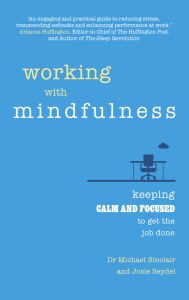Learn the top five ways to de-stress your commute.

When you are travelling to or from work on the tube it may well be that your most common experience whilst you are pressed up against that not-so-fresh armpit, with someone’s bag lodged in an inconvenient part of your anatomy, that you are simply wishing to be anywhere but where you are in that moment.
Even in conditions such as this though there is some interesting research that shows that even during negative experiences when we distract or daydream ourselves away we are actually less happy then if we are present to the ‘here and now’.
Mindfulness – an ancient technique for intentionally training ourselves to become more aware and observant of the present – can actually help us to literally re-wire our distracted brains to improve our attention and increase our happiness and well-being.
Mindfulness requires no special tools, abilities, spiritual virtues or self-denial, what it does require however, is lots of practice, patience, care and curiosity. Whilst there is plenty of research to substantiate that mindfulness really does help you to de-stress, the best test is to try it out for yourself. The following 5 exercises can be used on the tube as you commute at the start or end your working day as a way of developing some peace in amongst all the chaos.
1. Just one breath
– Just begin by noticing the body and any contact you have with the floor or ground. Find the sense of weight in the body, through the feet or pelvis especially, and allow yourself to use this to anchor yourself in present-moment awareness. Let yourself ‘settle’ in the body sensations of just this one moment.
– Now become aware of the sensations of breathing, in the mouth, the nose, the shoulders, ribs and belly.
– Focus on the breath at the tip of the nose and follow just one breath.
– Watch this breath enter the body and follow the sensations as your body receives air and oxygen
– As you release the breath, feel the natural sense of letting go and relaxation that comes with breathing out.
2. Train-ing the body and mind
– Like the previous exercise, use your body, especially any contact to the floor or seat (if you are one of the lucky few to get one) to centre your awareness. Notice the sensations of your feet on the floor, or of your rear-end on the seat. Be conscious of any pressure, temperature, tension, softness, absence of sensation, etc. Just observe this, as it is.
– Now become aware of how your body is being moved by the motion of the carriage or people around you. Notice the strong sensations as well as the more subtle ones, see how these are constantly changing.
– Notice how you are reacting and responding to the movement of your body. Are you aware of any thoughts? They could be something like ‘I wish that s*d would move his arm’, ‘I am so hot and uncomfortable’, ‘How much longer?’… or of course a multitude of other thoughts. See if you can just observe these coming and going, the strong and the subtle, without engaging with them.
– Notice also any emotions that may be arising in relation to the movement and sensations of your body. You might notice frustration, calmness, boredom …or anything else – any emotion is fine, just observe it, strong or subtle – no need to create any stories around it.
– If you find yourself compelled into thoughts, story-telling, daydreaming or other forms of distraction from the present then notice this and applaud yourself for catching this and then train your mind gently back to the sensations in the body that are present right now.
3. A sip of coffee
– Take hold of your coffee (or tea, juice, or other beverage). Feel the weight of the cup, can or bottle in your hand. Notice the sensations in your palm, fingers and on the back of your hand.
– Raise the drink to your lips with as much attention as you can bring to this action, feeling the sensations of muscles contracting, the movement of clothing or air on your skin and the anticipation as you put the drink to your lips.
– Take a slow sip, allowing yourself to savour the taste of your drink. Let it sit inside your mouth for a little bit so that you can notice the temperature, taste, thoughts and any feelings that are also present.
– Swallow the drink and see if you can feel it travelling on its way downwards.
4. Just a Moment
– Find your feet and your contact with the floor.
– Take just one breath and follow this in and out.
– Be aware of any thoughts swirling about in your mind.
– Notice any urges to ‘do’ something (e.g.: move, play with your phone, etc.).
– Tell yourself ‘ I have time for this breath/this body sensation/feeling just for one moment, I can allow this to be as it is.’
5. Phone it in
– If you have noticed that you are holding your phone, just notice this
– Feel the weight, textures and position of the phone as it sits in your hand.
– Notice the light, reflections and colours of the phone
– Be aware of any urges to fiddle, text or play with your phone.
– See if you can just sit with these and breathe for a moment as you watch these urges, thoughts and sensations arise and pass again.
Working with Mindfulness by Dr Michael Sinclair and Josie Seydel is out now, published by Pearson, priced £13.99








